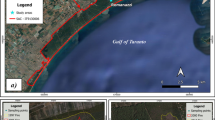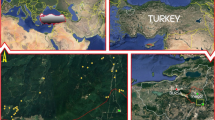Abstract
The dynamics, structure, and functional activity of microbial biomass have been studied in soils of felling areas in southern taiga fir forests (the Yenisei Ridge, Krasnoyarsk krai), which are at different stages of natural regenerative successions. The top organomineral horizons of soddy-podzolic soil (Albic Glossic Retisol (Loamic, Cutanic, Ochric)) of the after-felling regeneration succession (with the stage of secondary birch forests) is characterized by an increase in the content of carbon of microbial biomass (Cmic) and in the intensity of basal respiration from new felling to the stage of dense young forest. In the soil of the dense young-wood stage, the total reserves of Cmic (170 g C/m3) and microbial CO2 production (528 mg СО2–С/m3 per hour) are the highest and exceed the control by 80–85%. In the humus-accumulative soil horizon of the studied succession series, there is a tendency for a decrease in the portion of fungal substrate-induced respiration and in the fungi to bacteria ratio in comparison with the control. In the middle-aged deciduous forests with dark-coniferous undergrowth, all the considered parameters of microbial complexes decrease but remain higher than the control. A trend for a decrease in Cmic and basal respiration is revealed in the profile of soddy-podzolic soil of the regeneration series without species change over an eight-year period. At the stage of fir dense young forest, all ecological-functional parameters of the microbial complex become closer to the control small-grass–true-moss fir forest.





Similar content being viewed by others
REFERENCES
N. D. Ananyeva, Microbiological Aspects of Self-Purification and Sustainability of Soils (Nauka, Moscow, 2003) [in Russian].
N. D. Ananyeva, L. M. Polyanskaya, E. V. Stolnikova, and D. G. Zvyagintzev, “Fungal to bacterial biomass ratio in the forests soil profile,” Biol. Bull. (Moscow) 37, 254–262 (2010).
N. D. Ananyeva, E. A. Susyan, O. V. Chernova, I. Yu. Chernov, and O. L. Makarova, The ratio of fungi and bacteria in the biomass of different types of soil determined by selective inhibition,” Microbiology (Moscow) 75, 702–707 (2006).
T. V. Aristovskaya, Microbiology of Soil-Forming Processes (Nauka, Leningrad, 1980) [in Russian].
R. M. Babintseva, V. N. Gorbachev, and N. D. Sorokin, “Ecological aspects of reforestation with modern logging,” Lesovedenie, No. 5, 19–25 (1984).
I. V. Batura and A. V. Batura, “Reforestation of fir logging areas in the southern taiga of the Yenisei Ridge,” Lesn. Taksatsiya Lesoustroistvo, No. 2 (35), 78–81 (2005).
O. N. Bakhmet and M. V. Medvedeva, “Variations in soil properties upon artificial reforestation in Karelia,” Contemp. Probl. Ecol. 8, 838–844 (2015).
A. V. Bogorodskaya and E. A. Kukavskaya, “Soil microbial communities in soils of larch and light coniferous forests of Central Siberia after loggings and fires,” Lesovedenie, No. 5, 383–396 (2016).
T. A. Burenina, A. S. Shishkin, and A. A. Onuchin, “Snow cover on different-year loggings in fir– Siberian pine forests of the Yenisei Ridge,” Lesovedenie, No. 6, 26–36 (2013).
E. G. Gavrilenko, N. D. Ananyeva, and O. A. Makarov, “Assessment of soil quality in different ecosystems (with soils of Podolsk and Serpukhov districts of Moscow oblast as examples),” Eurasian Soil Sci. 46, 1241–1252 (2013).
V. N. Gorbachev and E. P. Popova, Soil Cover of the Southern Taiga of Central Siberia (Nauka, Novosibirsk, 1992) [in Russian].
A. A. Dymov, “The impact of clearcutting in boreal forests of Russia on soils: a review,” Eurasian Soil Sci. 50, 780–790 (2017).
A. A. Dymov, Candidate’s Dissertation in Biology (Syktyvkar, 2007).
A. A. Dymov and E. Yu. Milanovskii, “Changes in the organic matter of taiga soils during the natural reafforestation after cutting in the middle taiga of the Komi Republic,” Eurasian Soil Sci. 46, 1164–1171 (2013).
A. A. Dymov, “Soils of mechanically disturbed areas of forest logging areas in Komi Republic,” Lesovedenie, No. 2, 130–142 (2018).
A. B. Zhukov, I. A. Korotkov, V. P. Kutaf’ev, D. I. Nazimova, S. P. Regan, E. N. Savin, and Yu. S. Cherednikova, “Forests of Krasnoyarsk region,” in Forests of the Soviet Union (Nauka, Moscow, 1969), Vol. 4, pp. 248–321.
V. V. Ivanov, “Ecological consequences of mechanical forest loggings in the southern taiga of Krasnoyarsk region,” Lesovedenie, No. 2, 3–8 (2005).
L. B. Isachenkova, Candidate’s Dissertation in Geography (Moscow, 2007).
L. L. Shishov, V. D. Tonkonogov, I. I. Lebedeva, and M. I. Gerasimova, Classification and Diagnostic System of Russian Soils (Oikumena, Smolensk, 2004) [in Russian].
S. F. Kozlovskaya, “Yenisei Ridge,” in Highlands and Lowlands of Eastern Siberia (Nauka, Moscow, 1971), pp. 46–53.
Yu. N. Krsnoshchekov and N. D. Sorokin, “Soil-ecological changes on forest loggings and burnt spots of Eastern Khentei (People’s Republic of Mongolia),” Pochvovedenie, No. 1, 117–127 (1988).
M. V. Medvedeva and Yu. S. Kudinova, “Change of biological activity of soils during natural reforestation of pine woods,” Vestn. Povolzhsk. Gos. Tekhnol. Univ., Ser. Les. Ekol., Prirodopol’z., No. 1 (33), 17–25 (2017).
Yu. A. Orfanitskii and V. G. Orfanitskaya, Soil Conditions of Taiga Loggings (Nauka, Moscow, 1971) [in Russian].
V. E. Prikhod’ko and M. L. Sizemskaya, “Basal respiration and composition of microbial biomass in virgin and agroforest-reclaimed semidesert soils of the Northern Caspian region,” Eurasian Soil Sci. 48, 852–861 (2015).
L. M. Polyanskaya and D. G. Zvyagintsev, “The content and composition of microbial biomass as an index of the ecological status of soil,” Eurasian Soil Sci. 38, 625–633 (2005).
N. D. Sorokin, Microbiological Diagnostics of State of Forest Soils of Central Siberia (Siberian Branch, Russian Academy of Sciences, Novosibirsk, 2009) [in Russian].
Handbook on Climate of the USSR, No. 21: Krasnoyarsk Region and Tuva ASSR, Part 4: Air Humidity, Atmospheric Precipitation, and Snow Cover (Gidrometeoizdat, Leningrad, 1969) [in Russian].
Handbook on Climate of USSR, No. 21: Krasnoyarsk Region and Tuva ASSR, Part 2: Air and Soil Temperatures (Gidrometeoizdat, Leningrad, 1967) [in Russian].
E. V. Stolnikova, N. D. Ananyeva, and O. V. Chernova, “The microbial biomass and its activity and structure in the soils of old forests in the European Russia,” Eurasian Soil Sci. 44, 437–452 (2011).
E. A. Susyan, N. D. Ananyeva, and E. V. Blagodatskaya, “The antibiotic-aided distinguishing of fungal and bacterial substrate-induced respiration in various soil ecosystems,” Microbiology (Moscow) 74, 336–342 (2005).
E. A. Susyan, N. D. Ananyeva, E. G. Gavrilenko, O. V. Chernova, and M. V. Bobrovskii, “Microbial biomass carbon in the profiles of forest soils of the southern taiga zone,” Eurasian Soil Sci. 42, 1148–1155 (2009).
R. P. Titarev, Candidate’s Dissertation in Biology (Moscow, 2009).
G. P. Toshcheva, Candidate’s Dissertation in Biology (Moscow, 1988).
O. V. Trefilova and D. Yu. Efimov, “Changes in the vegetation cover and soils under natural overgrowth of felled areas in fir forests of the Yenisei Ridge,” Eurasian Soil Sci. 48, 792–801 (2015).
N. G. Ulanova, “Mechanisms of vegetation successions of clear cuts in spruce forests of Southern taiga,” in Proceedings of III All-Russia School-Conference “Actual Problems of Geobotany,” September 24–28,2007 (Karelian Scientific Center, Russian Academy of Sciences, Petrozavodsk, 2007), pp. 199–211.
J. P. E. Anderson and K. H. Domsch, “A physiological method for the quantitative measurement of microbial biomass in soils,” Soil Biol. Biochem. 10, 314–322 (1978).
E. Baath and T.-H. Anderson, “Comparison of soil fungal/bacterial ratios in a pH gradient using physiological and PLFA-based techniques,” Soil Biol. Biochem. 7, 955–963 (2003).
E. Baath, A. Frostegard, T. Pennanen, and H. Fritze, “Microbial community structure and pH response in relation to soil organic matter quality in wood-ash fertilized, clear-cut or burned coniferous forest soils,” Soil Biol. Biochem. 25, 229–240 (1995).
V. L. Bailey, J. L. Smith, and H. Bolton, “Fungal-to-bacterial biomass ratios in soils investigated for enhanced carbon sequestration,” Soil Biol. Biochem. 34, 997–1007 (2002).
F. Bastida, J. L. A. Monero, T. Hernandez, and C. Garcia, “Past, present and future of soil quality indices: a biological perspective,” Geoderma 147, 159–171 (2008).
E. V. Blagodatskaya and T.-H. Anderson, “Interactive effects of pH and substrate quality on the fungal-bacterial ratio and qCO2 of microbial communities in forest soil,” Soil Biol. Biochem. 30, 1269–1274 (1998).
M. Chauvat, A. S. Zaitsev, and V. Wolters, “Successional changes of Collembola and soil microbiota during forest rotation,” Oecologia 137, 269–276 (2003).
R. G. Joergensen and F. Wichern, “Quantitative assessment of the fungal contribution to microbial tissue in soil,” Soil Biol. Biochem. 40 (3), 2977–2991 (2008).
J. Pietikainen and H. Fritze, “Clear-cutting and prescribed burning in coniferous forest: comparison of effects on soil fungal and total microbial biomass, respiration activity and nitrification,” Soil Biol. Biochem. 27, 101–109 (1995).
E. Thiffault, K. D. Hannam, S. A. Quideau, D. Pare, N. Belanger, S.-W.Oh, and A. D. Munson, “Chemical composition of forest floor and consequences for nutrient availability after wildfire and harvesting in the boreal forest,” Plant Soil 308, 37–53 (2008).
H. Velvis, “Evaluation of the selective respiratory inhibition method for measuring the ratio of fungal: bacterial activity in acid agricultural soils,” Biol. Fertil. Soils 25, 354–360 (1997).
ACKNOWLEDGMENTS
The authors are grateful to R.T. Murzakmatov, Candidate of Biology, Senior Researcher, and to S.V. Zhila, Candidate of Biology, Researcher, for soil sampling.
Funding
This work was performed according to the basic project (АААА-А17-117101940014-9).
Author information
Authors and Affiliations
Corresponding author
Ethics declarations
The authors declare that they have no conflict of interest.
Additional information
Translated by I. Bel’chenko
Rights and permissions
About this article
Cite this article
Bogorodskaya, A.V., Shishikin, A.S. Dynamics, Structure, and Functional Activity of Microbial Biomass in Soils of Restoring Felled Areas in Fir Forests of the Yenisei Ridge. Eurasian Soil Sc. 53, 126–136 (2020). https://doi.org/10.1134/S1064229320010056
Received:
Revised:
Accepted:
Published:
Issue Date:
DOI: https://doi.org/10.1134/S1064229320010056




